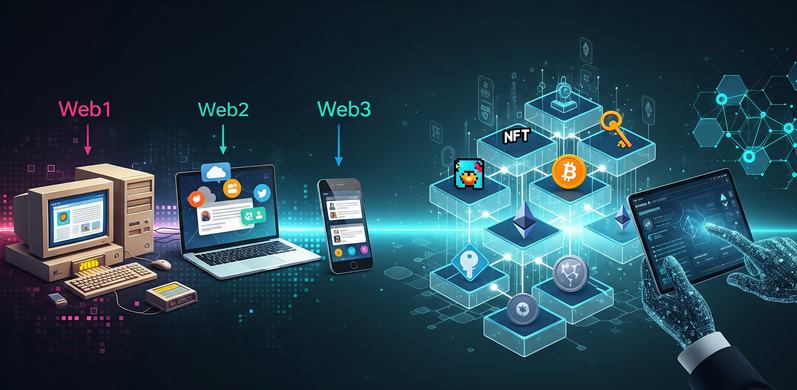From Web1 to Web3: Digital Ownership with Blockchain
The Internet, Unpacked: How We Got Here and Where We're Headed with Web 3Ever wondered how the internet became what it is, and where it's going next? It's a journey from simply looking at stuff to actually owning parts of the digital world. At the heart of this next big leap, often called Web 3, is something called blockchain technology. To really get Web 3, though, we need to quickly look back at its earlier versions.Web 1.0: The 'Just Look' InternetImagine the early 1990s internet. It was a bit like a giant digital library. A few people were the "publishers," creating static, mostly text-based web pages. The rest of us were just "readers". You could find information, sure, but there wasn't much you could do with it, or contribute yourself, beyond maybe a simple chat or forum post. That's why we call it the "read-only web".Web 2.0: The 'Talk Back and Share' InternetFast forward to 1999, and a designer named Darcy DiNucci came up with "Web 2.0". This was a huge shift! Suddenly, the internet became a two-way street. It was all about users getting involved and creating things. Think of social media, blogs, podcasts – these are classic examples of Web 2.0. It's the "read and write web," or the "participatory web". Your experience became dynamic. For instance, those short video apps? They give you a totally personalised feed based on what you like, because you're constantly interacting and contributing.Web 3: The 'Own Your Stuff' InternetThe term "Web 3" itself was coined by Ethereum co-founder Gavin Wood in 2014. It describes an internet that’s decentralised and built on blockchain. While it’s still very new and opinions vary on its exact shape, the general idea is clear: Web 3 will be open, decentralised, and puts you, the user, right at the centre.If Web 1.0 was just reading, and Web 2.0 was reading and writing, then Web 3 is about reading, writing, and owning.One of the big reasons for Web 3 is to fix some of the problems of Web 2.0. You know how a few huge tech companies pretty much run our digital lives? They've had the power to control, filter, and make money from everyone else's content, and they often make it hard for smaller players to compete.Web 3 aims to change that, giving users:• More control over your own personal data.• Better privacy.• Rewards for the data or content you choose to share.• The ability to interact, share information, and even make financial transactions directly with others.• A fundamental shift from just being a user of content to actually becoming an owner of content.You might have heard of Non-Fungible Tokens, or NFTs. These are seen as an early peek into how this ownership technology will work, letting you own your digital creations and data. Plus, blockchain will enable "permissionless digital identities" using crypto wallets, which could lead to fairer digital economies.Another cool idea in Web 3 is the "semantic web". This means computers will be able to understand and use information more like humans do, thanks to Artificial Intelligence (AI), smart data rules, and better sensor tech. Imagine information in the world serving your needs in a truly intelligent and dynamic way, like how AI is already making drug development or content creation much more efficient.How Blockchain Powers Web 3The vision for a future internet that's open, resistant to censorship, user-owned, and doesn't rely on central authorities needs new tech, and blockchain is the big answer to many of these goals. Even though blockchain is still evolving, it's designed to manage these decentralised systems.You can expect many crypto products to play key roles in this new web. Some existing crypto tools that are already being used to build the Web 3 ecosystem include:• Digital identity based on blockchain.• Crypto wallets.• DeFi (Decentralised Finance) services.• NFTs.• Tokenisation (turning assets into digital tokens).With the explosion of data, websites, and apps, Web 3 holds the promise of a more open, fair, and intelligent digital future. While no one can truly say what Web 3 will look like in its final form, it's up to today's entrepreneurs and users to build the next chapter of the internet. There will be huge opportunities for anyone who can contribute to this incredible evolution.
Conclusion
In summary, Web 3 holds the promise of a more open, equitable, and intelligent digital future, particularly in light of the vast expansion of data, websites, and applications. Although the precise nature of Web 3 is still developing and no one can accurately predict its ultimate form, its evolution is largely dependent on the contributions of entrepreneurs and users. This ongoing development presents enormous opportunities for those who choose to participate in shaping the next iteration of the internet.

